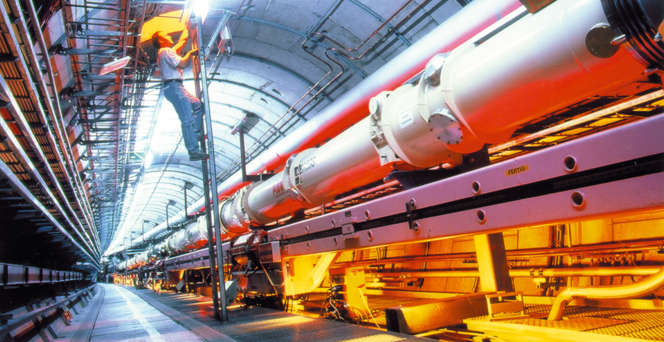URL: https://www.desy.de/e141261/e158573/e158772/index_eng.html
Breadcrumb Navigation

HERA
Particle physics experiments H1, ZEUS and HERMES
HERA was the largest particle accelerator at DESY and Germany’s largest research instrument. Over a time span of 15 years, the storage ring served the international particle physics community as the world’s most precise electron microscope for studies of the proton’s inner structure. Although the HERA experiments H1, ZEUS and HERMES ended in 2007, the ongoing data analysis continues to point the way for future particle physics experiments.
The HERA storage ring facility at DESY was the only one in the world in which two different types of particles were accelerated separately and then brought to collision. In a 6.3-kilometer-long tunnel located deep below Hamburg, lightweight electrons – or their antiparticles, the positrons – collided with hydrogen nuclei, i.e. protons from the hadron family, which are nearly 2000 times heavier. In these electron-proton collisions, the point-like electron acts like a tiny probe that scans the inside of the proton and reveals its inner structure. The higher the energy of the particle collision, the deeper physicists are able to gaze into the proton, and the more insights they obtain about the inner structure of the proton and the fundamental forces of nature.
There were four huge detectors at the HERA storage ring, which were operated by large international teams of researchers. The H1 and ZEUS experiments went into operation in 1992. They observed the high-energy collisions of electrons and protons in order to unravel the inner structure of the proton and the mysteries of the fundamental forces. The HERMES experiment started taking data in 1995. It used the HERA electron beam to investigate the intrinsic angular momentum – the spin – of protons and neutrons. From 1999 to 2003, the HERA-B experiment used the HERA proton beam to shed light on the properties of heavy quarks.
Unique insights
H1, ZEUS and HERMES were in operation until 2007, and between them they recorded a gigantic amount of data. During that time, many of the insights provided by HERA into the microscosm found their way into the physics textbooks. They are now part of the basic knowledge we have of the workings of our world. The journey of discovery is far from over, however. The evaluation of the recorded measurement data will provide exciting insights into the inner structure of the proton and the fundamental forces of nature for years to come.
H1 and ZEUS discovered, for example, that the proton comprises not only three quarks, but rather a seething particle soup in which quarks, antiquarks and the gluons that act between them constantly appear and disappear. H1 and ZEUS were also able to provide direct evidence that two of the fundamental forces, the electromagnetic and weak force, have the same origin: the electroweak force, into which the two forces unite at extremely high energies. The HERA experiments thus directly observed the effects of the first step toward the grand unification of the four fundamental forces of nature. H1 and ZEUS have also precisely measured the strong force acting between quarks. For the first time, a single experiment consistently demonstrated over a wide range of energies that the strength of this force changes – and it does so in the opposite manner from the other forces of nature: Quarks move more freely the closer they are to one another. The farther they are apart, the stronger is the pull of the strong force that, much like a rubber band, draws them back together.
To properly understand the spin of protons and neutrons, researchers must determine the contribution made by each individual member of the seething particle soup inside them. Exactly this was the strength of HERMES. The experiment’s special concept enabled physicists to separately measure the contribution made by each different type of quark to the total spin. In addition, HERMES was among the first experiments in the world to deliver direct evidence of gluon spin.
Model for international research projects
The unique insights HERA provided into the proton and the forces of nature form the basis for numerous other particle physics experiments, as well as for a variety of current developments in theoretical particle physics. The HERA results are used, for example, to improve the predictions for the particle collisions at the world's most powerful accelerator, the LHC in Geneva. The knowledge gained during the construction and operation of HERA is applied in new accelerator projects. Significant parts of the concept elaborated for the HERA proton ring, for example, were used in the design of the superconducting magnets of the LHC.
The construction of HERA in the 1980s was a prime example of successful international cooperation. A total of 11 countries contributed to the project – a first in the history of particle physics. Previously, it had been common practice to build the detectors within the framework of an international collaboration, whereas the accelerators themselves remained the responsibility of the host institute. HERA, however, was financed to more than 20 percent from abroad, the four HERA experiments to about 60 percent. This “HERA model” of international cooperation worked so well that it became a role model for carrying out large international research projects.
- Electron-proton storage ring for particle physics
- Length: 6336 metres
- Research operation: 1992-2007
- Data analysis ongoing
- Experiments: H1, ZEUS, HERMES, HERA-B


